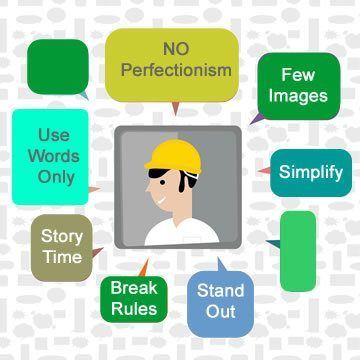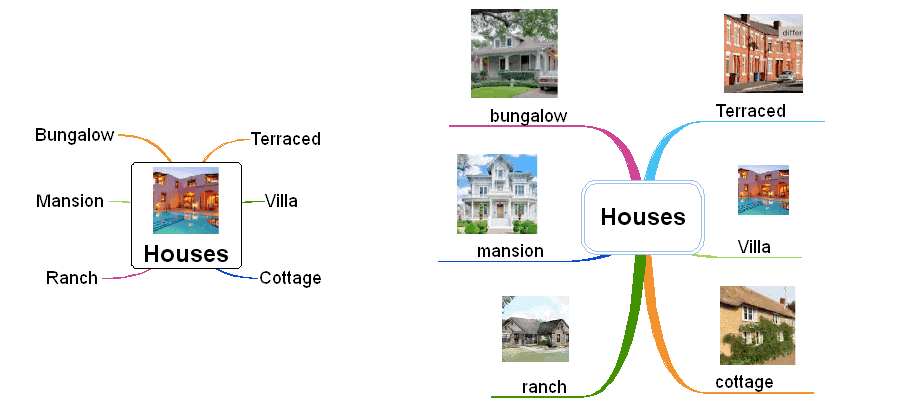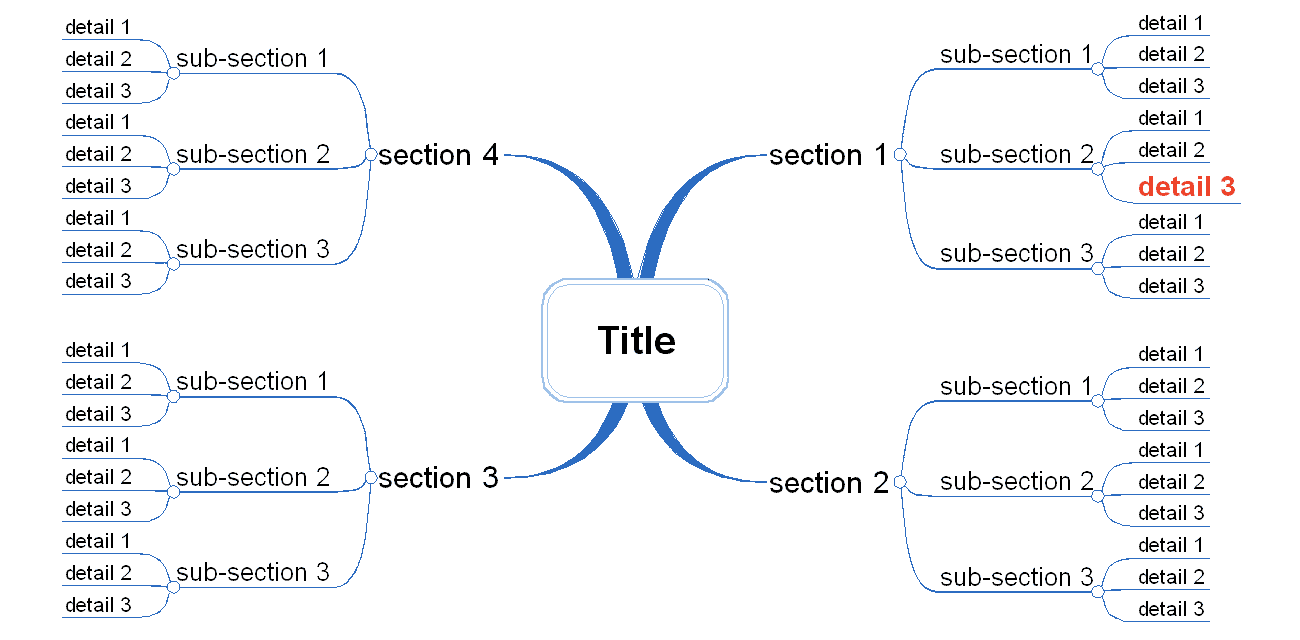We have all been there. When you follow all the rules of mind mapping you spend a lot of time on a map. And most of the time is not used productively. You may only need a quick overview of ideas, thoughts, or information. After you have that, you can take appropriate action.

So for everybody who is looking for a practical and productive way of mind mapping, I wrote this guide. I call this Practical Mind Mapping. Using this system, you will get understanding and clarity in your information. And it will be in a fraction of the normal mind mapping time.
Ready to learn simple mind mapping? Here we go!
There 7 Rules (Which You Can All Break If You Want) for Simple Mind Mapping
When I first started out with my martial arts, I was bound by all these rules, forms, and strategies. Now that I am a lot more skilled I can let go of them. The same applies to mind mapping. When you create maps using all the rules you will find out that some are more important than others.
After mind mapping many (many) times this way, I found out that maps remain as powerful and effective. The beauty was that my small tweaks resulted in huge reductions of mapping time. It was also a lot easier to create the map.
I like to start by saying that any rule I give you for Practical Mind Mapping is there to be broken, changed or ignored. It is all up to you.
The main goal of practical mind mapping is to create maps faster but with about the same outcome. The map is not the end goal. The map is only a “means to”. The outcome is understanding a topic you study, outlining a project, or anything else.
I know you want to get started. Here’s the first rule.
Rule 1: Use Words Only
O, my God… How can you say this!!! You need to use a word and many images. That is how we all learn to create mind maps.
Yes, you are correct. But…
Most of the time there is no need to create a map that has many images. You want an overview of thoughts or other information. Finding the right images means taking a lot of time from outlining!
Start with words only. The difference in time to create a map is huge, the result is about the same. It could even be a better overview!
Here is an example:
Real Life Experience:
I do workshops helping people to study faster and smarter. We start by creating a mind map based on their study book. It uses only words. After some training people can outline 100 to 200 pages of their books in 1 hour.
The beauty is that people understand most of their mind map (and book) after this one hour of mind mapping.
Can you imagine what their number of pages would be if they had to add images to all nodes in their map?
Rule 2: Use As Few Images As Possible
OK, sometimes you need some images. This could be a graph, a table, or an actual image of the topic you are mind mapping.
When you need it, you can add it. If you can leave it away from the map, don’t add it.
It is important that you don’t take too much time to find the right image.
If you are mind mapping a book, you may find the right image in the book itself. Take out your phone, snap a picture, and add it to the map.
Don’t try to find a perfect picture. You don’t need it. Go for a good picture. Chances are you won’t be using it too often. Why waste even 30 seconds on a ‘better’ picture then?
Real Life Experience:
Should you be working on a presentation using a mind map, only add images to the first level in your map. When you add (many) images to the lower levels of the map your map is getting too big! Have a look at the example below:

So, only add images when you need them.
Rule 3: Don’t Be A Perfectionist!
Perfection can be a blessing, but also a curse. For many people it is a bad thing which is stopping them from taking action.
What I tell my students in workshops is the following: Be a perfectionist, but only after you did most of the work. Mind mapping is not an activity that requires you to be a perfectionist.
And if you still need to be a perfectionist you should schedule time for it! Until you reach the time to be a perfectionist, you should just be moving forward and mind mapping (or reading, studying, etc.).
Real Life Experience:
During one of my workshops, I help people create a system for studying. When they use it, even the most stubborn perfectionist forgets to be a perfectionist!
They are all taking action. No need to think too much. When they are ready, you see that perfectionism may kick in.
And that is fine! When you finished your mind map you can do your perfectionism routine. BUT…
Only give yourself a couple of minutes to be a perfectionist. Do this only at the end of your study cycle or planning. Doing it during the creation of the map, you may fall back in your past (perfectionism) habits.
Rules 4: Simplify for Clarity
Clarity is King! When you communicate clearly, doors open.
A practical way of creating clarity is by simplifying. Ever heard of the Pareto Principle? The Italian economist Pareto found out that 80% of the capital was owned by 20% of the general population.
Well… this kind of ratio is also seen in many different other areas. Your work for example. 80% of your time creates 20% of the outcome. Find your 20% that creates 80% of the results, and you can become super productive!
The same with mind maps. 80% of the map is only showing 20% of the information.
What you can do is very Pareto. Many times, you can remove parts of each branch and still have the same information.
What you are looking for are words that are used over and over again throughout the branches.
If for example, you write about:
Mental Psychology -> Mental Disorders -> Psychology Case Study.
Some words can be removed. Words like Mental and Psychology. This is what remains:
Mental psychology -> Disorders -> Case Study
You end up with 4 words, which were 7 words. The context and information in the map are the same. Your brain will love you for simplifying.
Rule 5: Let your map tell a story
The things that you will find the easiest to remember are the stories that stand out.
When you are trying to memorize information, you will be trying to memorize the stories of the author.
Don’t fall for that!
You should be creating your own stories from the content of the book. That way you will be able to understand and recall it a lot faster and easier.
How to use this in real life?
Take the information in your map and look at it.
Start by looking at it from the first level in your map (this is the level that is closest to the center).
Are the words written in the right order? You can use something I like to call the Rule of Three. Most stories follow this rule. Here it is:
1. The Past – The Present – The Future
2. The Beginning – The Path – The End
3. Obstacle – Growth – Victory
You could also think about a flow like this:
1. Theory – Application – Result
2. Problem – Transformation – Greatness
3. The Start – The Journey – The Finish
Keep things simple and start working on the map. Create your own order in it.
Don’t be afraid to re-organize the map. When you are a little bit afraid of the outcome of the map, I just have to say… don’t worry. You can always copy the original map to a new file so you can play with the map content.
Find your own story. Connect it to the things that are relevant or important to you.
The story that you create is there for you only.
The result of it? You will be able to memorize the information faster and longer. All because of that little story you wrote!
Rule 6: Make important ideas stand out
Remember we may not even use images and colors in the map!
Well… that is about to change!
Some things in a map are more important than other pieces. That is fine! But it would be a waste not making the map show that. The map should be helping you out to understand the content a lot better.
This is where we will ‘get creative’ :).
There may be 1 to 3 things in your map that are important to you.
Go there and map the text BOLD or even bigger. Heck, you can even change the background color or the color of the font.
This will change the way you look at the map. It will even help you pin certain ideas into your mind. Just by adding some BOLD and bright red to the background of a map node.

You know what the best part is about working this way?
You don’t need the best images. You don’t need a lot of effort into finding images. And the best thing… your maps can be unique and much more powerful in only a few mouse clicks!
Changing colors and appearance in your map will make de map YOUR MAP. It is an image that is unique!
Oh… one last thing. Don’t put accents and highlights on everything. Doing it on every little node in your map completely destroys the power of this rule.
Rule 7: Break all the rules
Let’s be honest with each other. You are looking for a way to make mind mapping work for you. And if that means you can neglect a couple of rules, bend others, and follow the rest… that would be great!
You should be using all the rules and directions that will help you move forward.
Some people will love drawing images in a map. If you are not that kind of person… no problem! Draw less or don’t draw anything at all.
There is one very important idea that you should keep in mind. Don’t skip rules or break them when you “don’t feel like following that rule”.
Rules are there to help and guide you. Most of the time, our limits create freedom. So you should first learn to follow a rule. And when you definitely know that this is not something that will help you, skip, bend, or break that rule.
Cut Hours From Your Study Time
Conclusion, and What’s Next
The most important things you should learn from these rules are the following. Mind mapping is a great tool and it will be even better if you apply the rules at the right time.
Most of the time, there is no need for images or a map that is looking pretty. Many people use mind maps for outlining information. Do this with words and 2 or 3 colors.
Also, mind mapping is a means, not a destination. Take as little time as possible to make a good map. Perfection is not helping you in getting a good overview.
Mind mapping is a means, not a destination. Take as little time as possible to make a good map.
MindmapsUnleashed.com
Click to Tweet
What will you do to make your mind map better in less time?
Questions? Let me know!





Thanks Arjen for an interesting read. I would use the brainstorming tool, on mindmapping software, to get ideas out there rapidly. Then look at what I’d generated before thinking of structure. If I have time, I’d try acrostics and alliteration to make my mind map more memorable 🙂
Thank you Lorna! Very smart using the brainstorming feature of your mind mapping tool.
This is also something that is very useful when brainstorming in groups using mind maps!
Arjen,
Thank you for an interesting article.
I think that an underlying assumption for your article is that the mind map is to communicate effectively cleanly and succinctly for others.
Another use of a mind map is to take someone else’s article (or just a paragraph) and re-express their exact words as a mind map. This can filet open their argument into something far more visual than prose. The structure can jump out, making it easier to see, take notes on, and selectively hide or gray-out sections that are not relevant for the thesis you are developing for yourself and/or an external audience.
I’ve seen Jeff Conklin demonstration this here: https://www.youtube.com/watch?v=pxS5wUljfjE , highlighting the conversational structure, clarifying how subsequent statements relate to the last. Mind Maps are outstanding for relating in this way. Beyond a hierarchy, without needing to go to a full map.
I have used several of the MM software you have discussed. My go-to platform these days is FreePlane. I’ll spare you the rationale at this point. I mention this only because it has node splitting (using control s), and other aspects that make pasting in a paragraph and re-structuring it very fast and easy.
I hope that makes sense.
Thank you again.
Thank you for your thoughts Joe! Very interesting how you view these things. I watched the video. It makes a lot of sense to work this way. When you compare the comment stream in it with the map view… long live mapping 🙂 !
Using a (mind) map this way clarifies a lot. You use different maps on the same screen/sheet.
I will have another look at FreePlane. It has been a long time since I used it. Thanks again for your ideas!